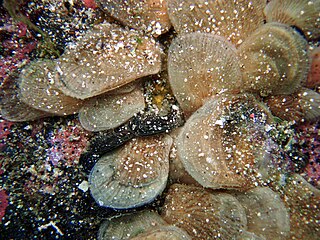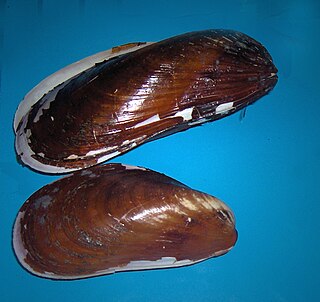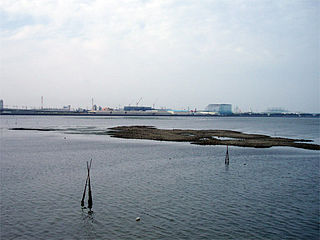
The eastern oyster —also called the Atlantic oyster, American oyster, or East Coast oyster—is a species of true oyster native to eastern North and South America. Other names in local or culinary use include the Wellfleet oyster, Virginia oyster, Malpeque oyster, Blue Pointoyster, Chesapeake Bay oyster, and Apalachicola oyster. C. virginica ranges from northern New Brunswick through parts of the West Indies and south to Brazil. It is farmed in all of the Maritime provinces of Canada and all Eastern Seaboard and Gulf states of the United States, as well as Puget Sound, Washington, where it is known as the Totten Inlet Virginica. It was introduced to the Hawaiian Islands in the nineteenth century and is common in Pearl Harbor.

The knobbed whelk is a species of very large predatory sea snail, or in the US, a whelk, a marine gastropod mollusk in the family Busyconidae, the busycon whelks.

The Scotch bonnet is a medium-sized to large species of sea snail, a marine gastropod mollusk in the subfamily Cassinae, the helmet shells and bonnet shells. The common name "Scotch bonnet" alludes to the general outline and color pattern of the shell, which vaguely resemble a tam o' shanter, a traditional Scottish bonnet or cap. The shell is egg-shaped and fairly large, 2 to 4 inches in maximum dimension, with a regular pattern of yellow, orange or brown squarish spots. The surface sculpture of the shell is highly variable: the surface can be smooth and polished, have grooves, be granulated, or even be nodulose on the shoulder of the whorls.

Melongena is a genus of sea snails, marine gastropod mollusks in the family Melongenidae, the crown conches and their allies.

Anomiidae is a family of saltwater clams, marine bivalve molluscs related to scallops and oysters, and known as anomiids. It contains seven genera.

Isognomon is a genus of marine bivalve mollusks which is related to the pearl oysters.

Modiolus modiolus, common name northern horsemussel, is a species of marine bivalve mollusk in the family Mytilidae.

Strombus alatus, the Florida fighting conch, is a species of medium-sized, warm-water sea snail, a marine gastropod mollusk in the family Strombidae, the true conchs.

Turbinella angulata, common name the West Indian chank shell or Lamp Shell, is a species of very large tropical sea snail with a gill and an operculum, a marine gastropod mollusk in the family Turbinellidae.

Lobatus costatus, formerly known as Strombus costatus, or commonly known as the milk conch, is a species of large sea snail, a marine gastropod mollusk in the family Strombidae, the true conchs. They are an edible species and important food source for the inhabitants of where they are found. Conchs are most notable for their medium to large-sized ornamental shells. Milk conchs are dispersed among the tropical waters of the Atlantic Ocean, along the coasts and islands of North, Central, and South America.

Oyster reef restoration refers to the process of rebuilding or restoring of oyster reefs all over the globe. Over time, oysters have been negatively affected by environmental change, such as harmful fishing techniques, over harvesting, water pollution, and other factors. The results of these factors have been disease and ultimately, a large decline in the global population of oysters and the prevalence and sustainability of oyster reefs. Apart from the ecological importance of oyster reefs, oyster farming is an important industry, particularly in coastal areas. Both artificial materials and natural components have been used to rebuild the reefs in an attempt to regenerate the oyster population thus fostering the reformation of reefs.

Ischadium is a monotypic genus of mussels in the family Mytilidae. The sole species is Ischadium recurvum, known as the "hooked mussel" or "bent mussel". It can be found along the Atlantic coast of North America, ranging from Cape Cod to the West Indies. They are often found growing on Eastern oysters, either intertidal or subtidal. They also attach to other hard substrates, including artificial reefs and dead shells of brackish water clams, Rangia cuneata.
Amygdalum papyrium, common name the Atlantic paper mussel, is a species of marine bivalve mollusc in the family Mytilidae, the true mussels. This species occurs along the Atlantic coast of North America, from Maryland to Florida, as well as in the Gulf of Mexico, from Texas to Mexico.

Isognomon radiatus, the radial purse oyster or Lister's tree oyster, is a species of bivalve mollusc in the family Isognomonidae. It can be found along the Atlantic coast of North America, ranging from southern Florida to Brazil and Bermuda.

Pteria colymbus, the Atlantic winged oyster, is a species of bivalve mollusc in the family Pteriidae. It can be found along the Atlantic coast of North America, ranging from North Carolina to Bermuda and Brazil.

Pinna carnea, commonly called the amber pen shell, is a species of bivalve mollusc in the family Pinnidae.

Spondylus americanus, the Atlantic thorny oyster, is a species of bivalve mollusc. It can be found along the Atlantic coast of North America, ranging from North Carolina to Brazil.

Enigmonia is a genus of saltwater clams, a marine bivalve mollusc in the family Anomiidae, the jingle shells. Enigmonia aenigmatica, the mangrove jingle shell clam, is the only species in this monotypic genus. It is found living on mangroves in the Indo-Pacific Ocean.

Saccostrea cucullata, the hooded oyster or Natal rock oyster, is a species of rock oyster found mainly in the Indo-Pacific Ocean.

Pinctada margaritifera, commonly known as the black-lip pearl oyster, is a species of pearl oyster, a saltwater mollusk, a marine bivalve mollusk in the family Pteriidae. This species is common in the Indo-Pacific within tropical coral reefs.



















